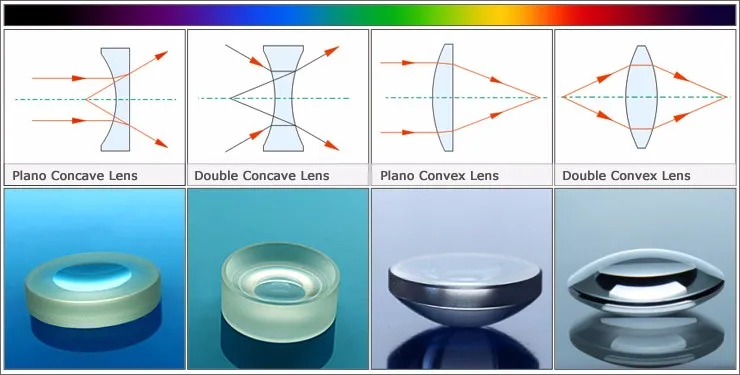We’ve been captivated by lenses since we were children. You can use them for various tasks, including studying small things and focusing on the sun’s beams. Convex lenses, on the other hand, are as fascinating. Typically, they are composed of glass or clear plastic.
It has at least one outward-curving surface, akin to the exterior of a spherical structure. Furthermore, you’ll note that a convex lens is the most frequent of all the lenses due to its versatility.
So, in this post, we’ll look at the definition, uses, Comparison of Concave and Convex lens and applications, among other things. As a result, you’ll find everything you need to know about these lenses right here. Continue reading to find out.
Table of Contents
Convex Lens
A typical optical lens is made up of two spherical surfaces. We call a lens a biconvex lens or simply a convex lens if those surfaces are curved outwards. The centre of these lenses is thicker, while the corners are thinner.
Furthermore, this type of lens can converge and concentrate a beam of light originating from the outside to a point on the other side. This point is referred to as the focus. The focal length of a convex lens is defined as the distance between the lens’s centre and the point of focus.
We’ll call it a plano-convex lens if one of the surfaces is flat and the other is convex. The convex lens is converging because it converges a parallel light beam on the principal focal point.
Uses of Convex Lens
Magnifying Glasses Contain this substance.
A magnifying glass is one of the important straightforward and straightforward applications of a convex lens. When light rays penetrate the magnifying glass’s convex lens, they focus on a particular focal point in front of the lens’s centre.
Once you’ve got the magnifying glass at the proper distance, you’re ready to go. Because the focal point will reach the item, you will magnify the object’s light beam to its fullest extent.
Cameras With Convex Lenses
Convex lenses are commonly employed in cameras to concentrate on an image as well as magnify it. Almost all camera lenses have a convex lens, followed by a concave lens, and then another convex lens. By shifting your body away from or towards the object, the first lens adjusts the magnification level of the image.
Used in Microscopes
Microscopes employ a convex lens to magnify images of extremely small objects. Three lenses are used in most simple microscopes. First, the lens at the end of a basic microscope produces an inverted and magnified picture.
Types of Convex Lens
The plano-convex lens, the double convex lens, and finally, the concave-convex lens are the three forms of these lenses. We’ll take a closer look at them immediately. To begin, a plano-convex lens curls outwards from one side while remaining plain on the other.
One spherical surface and one flat surface make up the positive focal length elements. These lenses are designed for non-critical applications that require unlimited parallel light.
Furthermore, you can use these optical lenses for a variety of focusing elements.
Then there’s a double convex lens that curves outward on both sides. It’s also known as a biconvex lens or just convex. The focus length of plano-convex lenses of the same diameter and radius is likewise shorter than that of cylindrical lenses.
Double convex lenses are preferred because many optical devices require greater focal lengths. They are used to power projectors, monoculars, telescopes, cameras, and other devices. It also produces a virtual image for the human eye as well as a real image for photography. On the other hand, a concave-convex lens curves inwards from one side and outwards from the other. We utilise it to compensate for the spherical aberrations caused by the other lenses.
Concave Lens
Lenses are essential ingestion that serves us in many ways. Glasses have had a significant impact on our existence as humans.
We would have to rely on our natural eyesight if we didn’t have lenses (which would be sad for those of us who don’t have 20/20 vision), we wouldn’t be able to do any form of photography, and we wouldn’t be able to watch television or movies if we didn’t have lenses. So is it even necessary for me to continue this list to demonstrate how lenses have altered our lives?
Convex and concave lenses are the two basic types of lenses. Convex lenses are frequently given all of the credit. They are the most popular lens used in photography and other common applications responsible for magnification.
Concave lenses, on the other hand, play a vital function. Any lens with an inward curvature in the middle is referred to as a concave lens. But the lens’ corners are thicker than the centre. As a result, light entering the lens spreads out or diverges. When viewed through a concave lens, this makes images appear smaller.
Uses of Concave Lens
Telescope
Concave lenses are used to magnify things in telescopes and binoculars. Because a convex lens causes blurring and distortion, producers of telescopes and binoculars use concave lenses before or in the eyepiece to help people focus more clearly.
Used in the Manufacture of Eyeglasses
Myopia, often known as nearsightedness, is most commonly corrected with concave lenses. Myopia is when a person’s eyeball is abnormally long, causing images of distant objects to fall short of the retina. As a result, concave lenses are utilised in spectacles to compensate for the shortage by spreading light rays out before they reach the eyeball. It allows the person to see items in the distance more clearly.
Peepholes
Peepholes, sometimes known as door viewers, are security devices that provide a 360-degree view of items outside of walls or doors. A concave lens is used to reduce the object’s proportions and give a wider view of the object or area.
Conclusion
I hope you understand the convex and concave lens concepts, which we discussed in detail in this article. If you have any related questions regarding this concept, drop them in the comment section provided.









